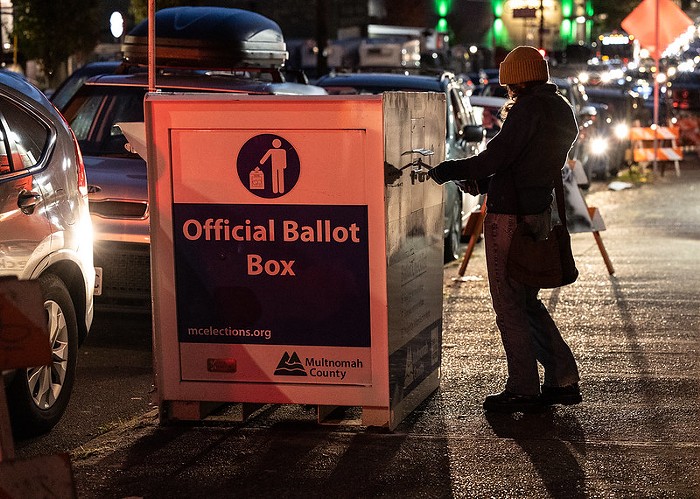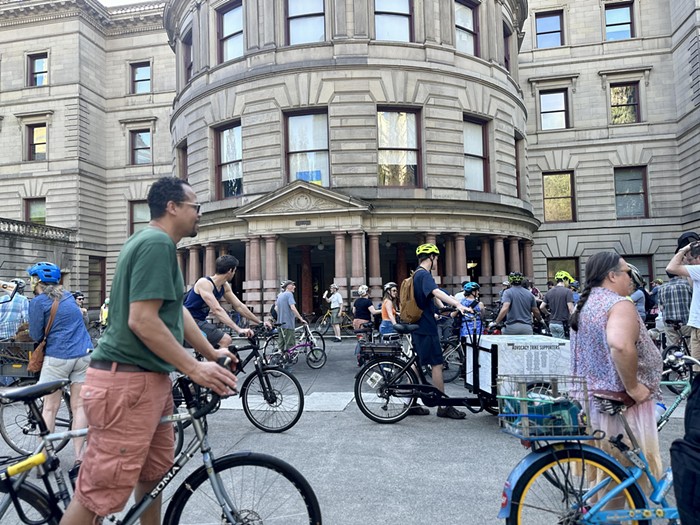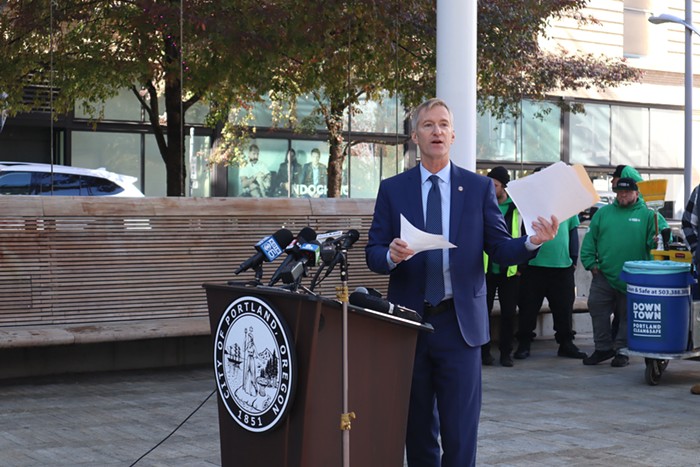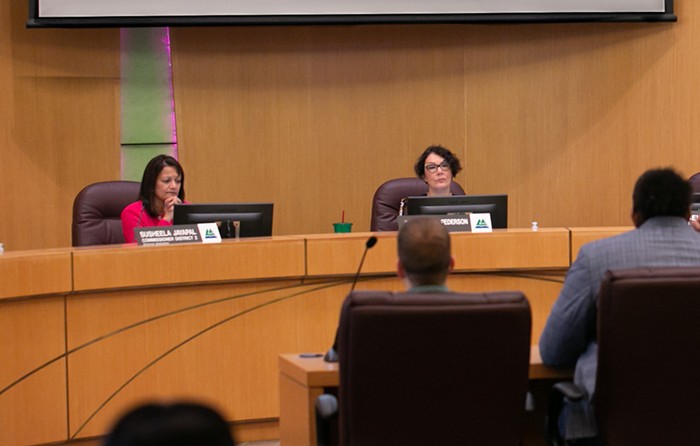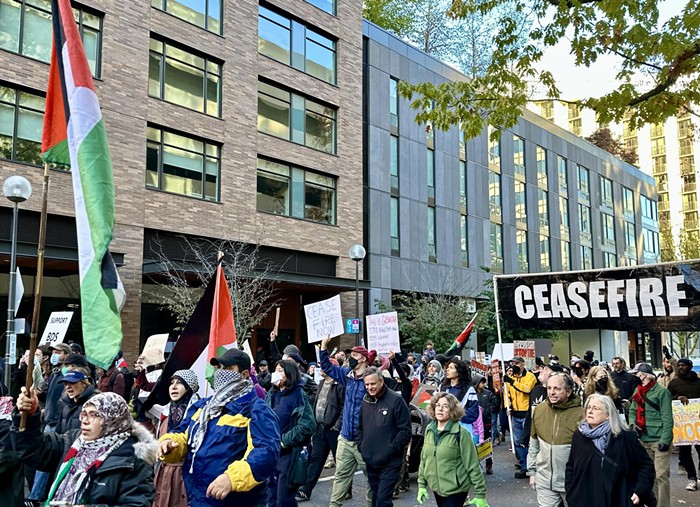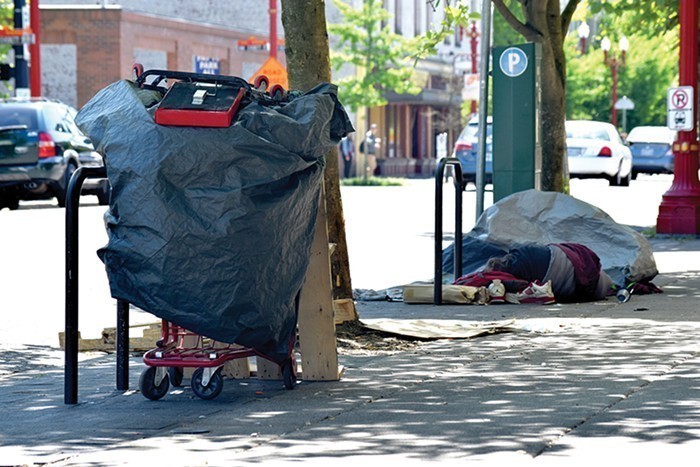
Barbie Weber’s day often begins with brewing a pot of coffee, taking a short walk around her North Portland neighborhood, and running a comb through her hair before hopping on a work Zoom call.
For many, this is an average morning in 2021. For Weber, and other formerly homeless residents of Hazelnut Grove, it’s freedom.
After years spent sleeping under bridges, on city sidewalks, and in crowded shelters—spaces where other people dictate when you wake up, make rules on how long you can stay, and cast judgement on how you spend your time—the ability to start the day on your own terms comes as a privilege.
“I feel like I’m in charge of my own life here,” said Weber, who became homeless a decade ago after losing her house in a predatory lending scheme and losing her successful job in marketing after a brain injury left her disabled.
“After being treated like children for so long… being told what’s best for us by strangers and referred to as second class citizens… it’s such a relief,” she said.
Weber moved into the 5-year-old tiny house village, tucked between N Greeley and Interstate, in February 2020. She spends most of her time advocating for homeless hygiene access and running Ground Score, a trash removal and recycling nonprofit she co-founded in 2019. And now, Weber and several of her Hazelnut Grove neighbors are fighting to keep their community whole.
On Monday, the City of Portland announced it’ll cut off its services to Hazelnut Grove—like trash pickup and portable toilet maintenance—within a month. The city, which owns the property but has never formally sanctioned the village, says the land’s environmental hazards pose too big a risk to its residents to keep allowing the community to call it home. Instead, the city’s offering to relocate the 15 Hazelnut Grove residents to St. Johns Village, a new publicly-run alternative shelter for homeless Portlanders made up of 19 sleeping pods, or to a space in another city shelter.
Most Hazelnut Grove residents are interested in leaving the current property, having grown tired of the constant threats of landslide, brush fire, pollution from nearby industrial yards, and hostile neighbors. That’s why residents have spent the past three years working with city officials to find a suitable property to relocate their community to. The city says that property is St. Johns Village. Yet some residents, including Weber, say the St. Johns space, which is overseen by a nonprofit with certain expectations for it residents, is not a fair substitute for the autonomously-governed Hazelnut Grove.
“Unless you’ve been homeless, I don’t think you understand how degrading it feels to be forced to live under someone else’s rules, just because you are poor,” said Weber.
As some Hazelnut Grove residents pack up to move and others petition the city to find another location, the solutions remain imperfect. Yet the conversations surrounding the decision show just how far the city has evolved in terms of understanding and addressing homelessness since Hazelnut Grove first appeared in 2015. At that time, the idea of alternative shelter—whether it be a cluster of tiny homes, heated sleeping pods, or tents on elevated platforms—was seen as a radical one by city officials, a solution that came directly from the homeless community and its advocates who weren’t satisfied with waiting for the city to solve the affordable housing crisis.
Now, these in-between forms of shelter are central to the city’s response to homelessness, with city-run villages serving as an effective entry point for people whose needs haven’t been met by traditional housing placement programs and as emergency shelter during the COVID-19 pandemic. And, with an expected post-pandemic surge in homelessness on the horizon, it’s a solution that city leaders are even more committed to expanding.
While Hazelnut Grove’s days may be numbered, the community it fostered has laid the groundwork for more alternative housing opportunities for houseless Portlanders. At the same time, its impending closure shows the need for diverse shelter options for those whose needs might not match the city’s agenda.

Hazelnut Grove began as a protest. In 2013, the remnants of 2011’s Occupy Portland camp in Chapman and Lownsdale squares had restructured into a homeless encampment protesting the city’s housing crisis. Occupy Portland activist Meg Garcia joined the camp in 2014 after she could no longer afford to pay the constantly increasing rent at her Portland apartment, and was placed on a long waiting list for affordable housing support.
“It was both a way to protest the city’s housing crisis and to create community,” said Garcia.
But it wasn’t a sustainable solution. Each morning, campers had to pack up their tents to clear the sidewalk, and spent most of the day carrying their possessions with them as they ran errands to avoid theft. When they heard that Sisters of the Road Cafe needed someone to keep a watch on their North Portland garden plot, the small group of campers jumped at the opportunity to relocate.
By October 2015, Garcia and other campers had moved their encampment to a city-owned hillside just southeast of Overlook Park, neighboring the Sisters garden. Under the new name Hazelnut Grove, the community—then only a collection of tents on wooden platforms—began holding assembly meetings to develop structure and responsibilities, including security, meals, and advocacy work. The move coincided with then-Mayor Charlie Hales’ citywide declaration of a housing state of emergency, a call that tweaked zoning rules to allow for more homeless shelters and day storage facilities for homeless Portlanders. It also left Hales more open-minded about organized homeless camps.
“I remember that, not long after we moved, someone from the city came by and asked how they could help us,” said Garcia. “We had to pick our jaws up from the ground.”
Instead of condemning the site and preparing to clear the area—the city’s usual response to unsanctioned encampments—city staff offered to supply the community with portable toilets, trash pickup, and fencing, costing around $1,500 a month. Josh Alpert, Hales’ chief of staff at the time, said his office saw Hazelnut Grove as an opportunity in the midst of an unparalleled housing crisis.
“We knew we didn’t have the amount of housing needed to help our city’s homeless population, and we knew it wasn’t going to be created overnight,” said Alpert. “We also couldn’t just let people sleep outside until then.”
Inspired by the success of self-governed houseless villages like Right 2 Dream Too and Dignity Village, Alpert said Hales was interested in finding land where the city could provide temporary housing for homeless Portlanders until the city had enough permanent housing to transition them into.
“But we needed a test case,” Alpert said. “At Hazelnut Grove, there was this spirit of self-determination and willingness to make something work, so we thought, ‘Why not give it a shot?’”
It was an imperfect experiment: The city property was in a wildfire hazard zone and an area prone to landslides, a risk campers faced head-on that winter when heavy rains flooded their tents with mud. In response, residents constructed a collection of lifted tiny homes out of donated wood and other building supplies. In the drier months, they met with the city fire marshal to identify fire risks and brush that needed clearing. And then there was the neighborhood association.
Overlook Neighborhood Association (which uses the acronym OKNA) has consistently used the threat of environmental hazards to protest the existence of Hazelnut Grove in their neighborhood. But the argument often cloaks a more deep-seated discomfort about people experiencing homelessness. OKNA welcomed their new neighbors in December 2015 by demanding the city provide them a list of Hazelnut Grove residents’ names, so that OKNA could run background checks on them. In 2016, OKNA joined a Portland Business Alliance lawsuit against Hales’ temporary policy allowing homeless Portlanders to camp on city property. After the city rebuffed OKNA’s repeated calls to shutter the camp, OKNA eventually decided in 2017 to bar homeless people from attending their monthly meetings. OKNA only backpedalled when the city threatened to formally disband the association over discriminatory practices.
"We saw that, once you eliminate those basic needs, people are able to wrap their head around their future and actually ask themselves, ‘Oh, what do I want?’”
Yet by all other measures, Hazelnut Grove has been a success. In the first year, residents worked together to build a community space, library, garden, tool shed, and communal kitchen. A job posting board connected residents with short-term work and volunteer opportunities. People who’d spent their lives on the street, living day-to-day, began planning for the long term.
“A lot of people came to us cold, tired, and hungry,” Garcia said. “We saw that, once you eliminate those basic needs, people are able to wrap their head around their future and actually ask themselves, ‘Oh, what do I want?’”
When people showed signs of untreated mental illness or substance abuse, community members checked in with them and helped steer them toward care. If residents posed a safety threat to the community, they were asked to leave. Portland Police Bureau (PPB) data shows that after Hazelnut Grove’s arrival, the surrounding neighborhood observed a decrease in criminal activity. The hillside hasn’t caught fire or been destroyed by a landslide. Perhaps the most measurable success: At least 40 people have moved out of Hazelnut Grove and into permanent housing since 2015.
But the neighbors’ hostility has worn on the villagers.
“It’s not comfortable living in a community when you know you’re not wanted there,” said Bob Bremmer, who’s lived in Hazelnut Grove since 2015. “It messes with your own self-worth.”
Combined with the area’s environmental safety risks, this persistent pressure from OKNA encouraged Hazelnut Grove residents to begin meeting with the city in 2018 to discuss a move to a more welcoming plot of land. By then, the city had formed the Joint Office of Homeless Service (JOHS) with Multnomah County to oversee shelter development, including the possibility of alternative shelters like Hazelnut Grove. JOHS and the mayor’s office, now occupied by Ted Wheeler, offered to cover the costs of relocation to another property if the villagers agreed to allow a homeless nonprofit to oversee the program—a structure mirroring the Kenton Women’s Village, opened by JOHS in 2017.
With the residents’ approval, the city appointed homeless shelter provider Do Good Multnomah to carry out that role.
In an formal agreement between Do Good Multnomah and Hazelnut Grove, signed in November 2018, the parties agreed that the nonprofit would be in charge of day-to-day management of a new village, mediation between villagers, and finances, while the villagers would be in charge of maintenance and responsible for obtaining renters insurance.
The city’s first proposed relocation property in St. Johns fell through after city planners belatedly realized it couldn’t support enough tiny homes. The city eventually struck a deal with St. Johns Christian Church, which offered to lease its N Richmond property to house the village.
After several delays, St. Johns Village—which boasts electricity, plumbing, a community kitchen, 19 sleeping pods, and on-site case management—is now set to open on February 1.

It’s the final steps of this deal that caught Hazelnut Grove residents off guard. Many of the residents say they were under the impression the new village wouldn’t require case management or expect tenants to transition to long-term housing, something St. Johns Village will focus on. Weber says that the feeling of stability in the new village could be shattered by management’s expectations of residents to find other housing.
“It’s undermining the entire purpose of a tiny home village,” said Weber. “To empower people to be in control.”
In December, Weber began circulating an online petition, calling on the city to halt the village's closure until it can identify another piece of property where residents won’t be required to leave, and can be truly self-governed. It’s gained more than 2,500 signatures in the past month.
The petition reignited OKNA’s campaign to close Hazelnut Grove, inspiring the board to send a letter to Portland City Council last week.
“The current situation is a humanitarian catastrophe. Living outdoors puts people’s health at risk and leaves them vulnerable to victimization,” the letter reads. “Meanwhile, campsites are causing environmental damage to our communities, rendering public spaces and parks unusable by the public.”
OKNA vice chair Chris Trejbal, who’s been on the neighborhood association’s board since before Hazelnut Grove opened, told the Mercury that the board’s concern is less about the actual residents of Hazelnut Grove—but more about what activity they could attract.
“Neighbors are concerned that the presence of Hazelnut Grove and the city’s willingness to allow it to remain on site emboldens people to think that Overlook is a good place for camping,” said Trejbal. “That, and that site... it’s just not a healthy place for a camp to be.”
Trejbal said he’d like to see the area closed to campers by the end of the summer, at the latest. He envisions the space being turned into a dog park or a public park with off-road bike trails.
A week after receiving the OKNA letter, the city made its intentions to shutter Hazelnut Grove final in a press release.
“Within the next month,” reads the statement. “The city will ensure nobody remains at Hazelnut Grove to protect health and safety while the site is restored.”
"The more choices people have, the better. If one model doesn't work for someone, then something else hopefully will.”
Half of the remaining Hazelnut Grove residents have decided to stay put in protest, while others plan to move to St. Johns Village.
That includes Bremmer, one of the village’s original tenants. Bremmer helped plan and construct many of the current tiny homes at Hazelnut Grove, and recently obtained his contractor’s license to start his own construction business, where he hopes to focus on alternative shelters. While he agrees that Hazelnut Grove residents may have been misled in the city’s relocation deal, Bremmer doesn’t want to stand in the way of the city’s future investment in villages for homeless Portlanders.
“It seems that if the village movement should continue and thrive and be inclusive of the people in the program, stability is needed,” said Bremmer. “To protest to change the city policy on it, means forgoing guaranteed stability. To me, it’s worth giving a little ground to show how excellent these programs can be.”
Christine Alix, who lives at Hazelnut Grove with her husband, said they are also moving to St. Johns Village in search of stability. She fears the unrest that a standoff with city officials could bring to her quiet home in Hazelnut Grove.
“I’m not looking forward to giving up some of my rights by leaving here,” said Alix, who spent years unhappily cycling through the city’s shelter system. “But I can deal. It’s not a shelter, at least."
Garcia moved out of Hazelnut Grove last March, and now lives in Clackamas County Veterans Village, a tiny house village that Do Good Multnomah opened in 2018. She supports her former neighbors’ pursuit of a self-governed village, but said that she’s appreciated living in a more structured shelter model.
“Personally, it was amazing to go from a village that needed constant upkeep and maintenance [like Hazelnut Grove] to one that was already set up and ready to go when I arrived,” said Garcia. “And I really love having hot water and electricity. But that’s just me. I think choices are incredibly important.”

Denis Theriault, a spokesperson for JOHS, doesn’t disagree. Theriault said that for Hazelnut Grove, the JOHS plan has always been to create a village that serves as a stepping stone to more permanent housing, but understands that “that’s not necessarily going to be the right model for everyone.”
“This is the way the [JOHS] choses to run its shelters,” said Theriault. “But it’s important to acknowledge that there’s a lot of other ways to approach alternative shelter. The more choices people have, the better. If one model doesn't work for someone, then something else hopefully will.”
While JOHS oversees St. Johns Village and Kenton Women’s Village, it doesn’t have a monopoly on Portland’s alternative shelter network. Both North Portland’s Dignity Village and the Rose Quarter’s Right 2 Dream Too offer membership for homeless Portlanders seeking to live in a tiny home community. Neither nonprofit-run program mandates residents seek other permanent housing during their stay. Southeast Portland’s Agape Village, a private alternative shelter run by Central Nazarene Church, also describes itself as “self-governed.”
A new city proposal could further broaden the options for homeless Portlanders who don’t see their values reflected in JOHS’ alternative shelter model. On April 4, the housing state of emergency originally declared in 2015 is set to expire, and it’s not yet clear if Wheeler intends on renewing it. In preparation, the city’s Bureau of Planning and Sustainability (BPS) is poised to make part of the zoning shortcuts embedded in the declaration permanent—and then some.
The draft proposal, which is expected to reach council in March, would allow temporary indoor or outdoor shelters in all commercial zones of Portland for up to six months without a permit. This includes “village-style” outdoor shelters, which could house up to 40 people under the new rules.
The proposal would also create a clear pathway for alternative shelters to gain permanent approval, replacing the city’s case-by-case permits and agreements that allow spaces like Dignity Village and Right 2 Dream Too to remain open. If approved by council, the code change could allow for more privately operated villages—offering various standards, priorities, and services—to pop up across Portland.
This proposal has the support of City Commissioner Dan Ryan, whose office oversees JOHS. Ryan said he wants to see a wider variety of alternative shelters across Portland that are able to meet people’s different needs—whether that’s a village that caters to people with unique mental illness needs or those with a substance use disorder.
“That’s the beauty of alternative shelters. Sure, it’s going to be messy and complex, but that’s how life is."
Since entering office in mid-2020, Ryan has organized regular meetings with Wheeler, Multnomah County Board Chair Deborah Kafoury, and Multnomah County Commissioner Sharon Meieran to specifically discuss the future of alternative shelters.
Last week, the four elected officials reached a substantial agreement: They would ask the community to propose different alternative shelter models, and use funding from Metro's new homeless service tax to bankroll the best ideas. The JOHS expects to formalize the public request by the end of February.
“We have to have multiple solutions...we are in an emergency,” said Ryan. “It’s time to treat it like one. The city must be nimble.”
Ryan credits Hazelnut Grove with expanding the definition of what alternative shelter could look like in Portland. But he’s not blind to the power dynamics at play that’s ultimately left residents dissatisfied.
“Dignity is so important. You have to allow people to build their own resilience, not force it on them,” said Ryan. “So, it might feel like it takes longer than it should, but the results are better. That’s the beauty of alternative shelters. Sure, it’s going to be messy and complex, but that’s how life is.”

